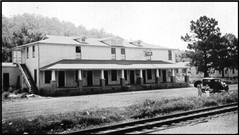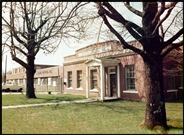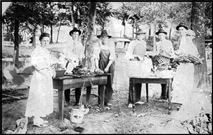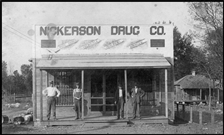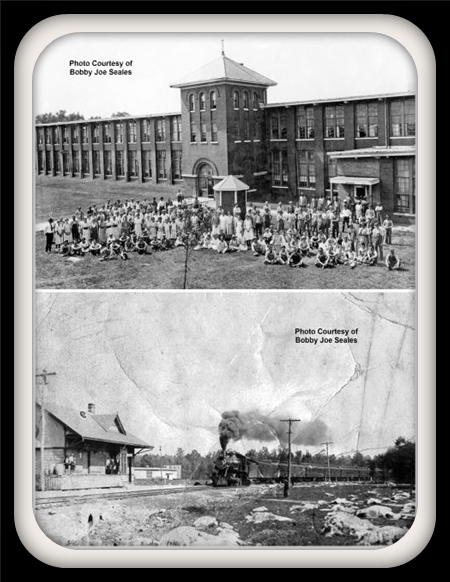|
"Beginning of Construction Dates Back to Year 1903"
Thomas Carlyle Thompson, third
child born of Jesse Sampson Thompson, 1825-1872, and Henrietta Collins,
1826-1903, was born in Oak Bowery, Chambers County Alabama on June 22, 1850.
However, all early census records indicate that he was born in 1851. He died in
Siluria, Shelby County Alabama on October 5, 1922 and is buried in Oak Hill
Cemetery in Birmingham, Jefferson County Alabama. He was a pioneer "master
builder" in the southern textile industry.
Jesse S. Thompson and his family, one of the city's
pioneer families, came to Birmingham, Jefferson County Alabama in 1871. He
died July 5, 1872 and was the
first interment in Oak Hill Cemetery in Birmingham, Alabama. His oldest
child, Miss Cornelia A. Thompson, 1848-1935, was prior to the time of her death
on February 11, 1935 "the only surviving charter member of the First Methodist
Church" in Birmingham, Alabama. His oldest son, Burges Asbury Thompson,
1850-1922, was a former "pioneer mayor" of Birmingham, Alabama serving from
1888-1890. Another son, William H. Thompson, 1866-1913, played an important role
in the first incorporation of Siluria Cotton Mill Company.
T.C. Thompson married Miss Julia N. Seaman in Jefferson
County Alabama on October 11, 1883. They moved to Shelby County Alabama and in
the early 1900's built a beautiful two-story home that resembled a small mansion
on the West Side of Alabaster, known as Blue Spring Farm.
Julia Nancy (Seaman) Thompson, 1866-1940, death record indicate that she died
in Shelby County Alabama on October 24, 1940. A day remembered by many, "Mrs.
Thompson was cremated and her ashes were dropped from a low-flying airplane over
the orchard on the farm, which was famous for its peaches." However, Oak
Hill Cemetery records indicate Mrs. Julia N. Thompson's date of interment was
December 18, 1940, and her "cremated remains were placed in a brick vault
grave." She was the daughter of George Edward Seaman and Sarah Frances Hudgins.
EVER WONDERED WHEN THE "SPLIT" TRACKS WERE BUILT THAT RUNS THROUGH ALABASTER AND SILURIA? On Tuesday, September 16, 1902, The Birmingham News, "informs
us the extra north-bound freight train, engine
No. 361 and second section south-bound freight train, engine No. 873, had a head-on collision last night at 10:25 o'clock a short distance south of Siluria, and about twenty-five miles
south of Birmingham. As a consequence Fireman W. Nix, colored, of the south-bound train, was killed and six other men were more or less hurt. Both engines were damaged some though not seriously, and four cars were entirely destroyed.
The collision took place on the old main line (the track that travels through
Siluria). At midnight the new main line was used for the first time, in giving the south-bound train orders last night it was understood that the train
would use the new main line. However, the order was not delivered to the crew to use the new main line and so it came to pass that the two trains going in opposite directions met on the same
tract, in the old main line." (The track today still carries the south bound
trains through Siluria and the track today still carries the north bound trains through Alabaster.)
Announced in The Shelby Sentinel, Calera, Alabama, dated April 2,
1896, "Selma's Cotton Mill Contract. The contract for the erection of the Selma
Cotton Mill company's plant has been awarded to T.C. Thompson & Bro., of
Birmingham. Dirt will be broken April 15, and the building will be completed by
September 1. The building will be erected on the new Praray system (an 1894 patented
building method by Charles A.M. Praray). The company was organized one year
ago, and has raised $100,000 at $1 per week per share of stock. The holders as
a rule are wage earners." The Selma Times, dated Saturday, August 10,
1895 states "The establishment of a new cotton mill in Selma is gratifying. This
mill will be built by home money, and create a demand for the product of farm
and mine." As noted in The Montgomery Advertiser, "September 1, 1896, (SPECIAL) ... Work is progressing rapidly on the plant of the Selma Cotton mill company and everything will
be in readiness to receive the machinery which will begin to arrive in a short time. Work began today on the cottages for employes, they will be neat, comfortable and substantial four
room houses. Twenty-one are to be built." The first President of Selma Cotton Mill was Ernest
Lamar. I TELL YOU THIS SO THAT YOU WILL NOT GET SELMA
COTTON MILL CONFUSED WITH THE SILURIA COTTON MILL. The Birmingham News, dated Thursday, December 11, 1902, "Work Will Start
on Siluria Cotton Mill January 1 (1903). Work on the plant of the Siluria cotton mills company, whose purpose to erect a mill at Siluria will begin
about January 1 (organized with a capital of $250,000). The mill building will be 270 feet long and 75 feet wide, two stories high. There will be 300 looms to begin with, and the plant will give employment to about 150 hands.
The mill will be operated upon the same plan as the famous Olympia mill in South Carolina, with which Mr. Brevard D. Miller, secretary of the new company, was connected.
The machinery will be driven by electricity and the mill will be modern throughout as can be made. Siluria, the site of the new mill, is located on the Louisville
& Nashville road,
about twenty miles from Birmingham." For many years the mills of Alabama have
mostly confined themselves to yarns, shipping them off to other mill centers to
be worked into cloth. However, provision of the Siluria Cotton Mill have been
made for cloth of mercantile grade. By Friday, October 7, 1904 The Birmingham News tells us that "The Siluria cotton mill is making splendid progress. About 6,000 spindles and 150 looms are now working. The first shipment of
finished product, which is 28-inch print goods, was made Tuesday of this week, to New England states, where it goes to be printed." Under constrction at the present time, as noted in The Birmingham News, dated Wednesday, July 1, 1903, "new 10,000-spindle cotton mill and operatives' cottages for the Siluria Cotton Mills Company,
at Siluria, Ala...." They have every prospect of making the enterprise one of very great success, and its
establishment marks a new era in the plan possibilities and fast-coming
development of the county."
INSERT - TIMES BEFORE (AND AFTER) THE COTTON MILL: The Herald-Journal,
Bessemer, Alabama, Thursday, July 20, 1893, "Siluria, July 17. - [Special.] -
Siluria is a beautiful little village situated on the old reliable L. and N.,
R.R. about 23 miles south of Birmingham. The chief industry of this place is
manufacturing of lime...." In the 1870's there were several lime works located in Siluria
and now the current Alabaster City limits - and continues
today to be several in operation: (1) Siluria Lime Works on the South and North Alabama Railroad, owned and operated by Holt, Johnson & Warren, and (2) the Shelby Guide, dated
July 30, 1874, informs us that "Col. Wagner, of Montgomery (Col. Charles G. Wagner, 1818-1895,
he died in Shelby County Alabama on August 21) has just finished a lime kiln at Siluria. It is said to be the prettiest piece of workmanship in the State. We
understand he intends building another soon." In 1895 The Shelby Sentinel,
says "a short time since we had the pleasure of going through the large
establishment for the manufacture of lime and barrels, of Col. C.G. Wagner, at
Siluria, in this county. The whole structure is a model of its kind, and the
proprietor's knowledge of his business has enabled him to introduce such
improvements in machinery, etc., as greatly to facilitate the manufacture of a
superior quality of lime, and lessen the expense considerably. He and his two
polite and intelligent sons (Thomas R. Wagoner and Dr. Effingham Wagoner), lend
a hand and make every edge cut. On December 15, 1904, it was reported, "Siluria is the center of the most prosperous section of Shelby county
(with lime kilns, coal mines and the Siluria Cotton Mill). The purest lime in the
State is manufactured in that district. Within a radius of three miles of that place there is a daily output of about 3,000 barrels of lime a day.
Just two miles west of the formation changes and the finest domestic coal in the South is being mined by the Climax Coal Company
(all coal mines in this area and in Shelby County are now closed and out of
business)."
The Birmingham News, dated Friday, September 2, 1904, "Special to The Birmingham News. SILURIA, ALA. - "Plans have been made for the erection of a local church (this was the
Siluria Methodist Church). Heretofore there has been no church here, and those who would attend services on Sunday had to walk about two miles. The coming of the new church is, therefore, looked
forward to with a great deal of pleasure. The old stereotype style has been carefully avoided and we expect to have a very pretty building."
Articles of the incorporation of Siluria Cotton Mill Company was originally
filed by the Siluria Real Estate Investment Company
under the laws of the State of Delaware on November 17, 1902. The main section
of the mill was built in 1903-1904, the office was built in 1906, and the first
addition to the main section of the mill building was in 1911. It was
re-incorporated in the State of Alabama under the same name on February 6, 1908.
On April 6, 1911 the name was changed to Buck Creek Cotton Mills, at which time
certain changes were made in the issues of outstanding capital stock with an
increase from $250,000 to $600,000. As reported on October 22, 1912 at the
stockholder's meeting, "We have kept the mill and village in good repair and
have tried to improve our organization, which we believe we have done. Our
village is in good shape at the present time, clean and healthful and we also
have a good church and have this winter a good school with two teachers and from
50 to 60 scholars, all of which is necessary to improve the efficiency of our
help."
As noted in the Shelby County Reporter, dated Thursday, June 25,
1931, "... The Siluria Ice Plant has been operating for fifteen years ...."
In the spring and summer of 1921 a four-class room "high
school" building and auditorium was constructed next to the existing five-class
room elementary and junior high school building in Siluria, Shelby County
Alabama. In the fall of that same year school started, thus, becoming the
second consolidated school in Shelby County Alabama. Owing to the generous
donation of property and personal funds from Thomas Carlyle Thompson, the school
was named Thompson, which was the beginning of Thompson High
School.
It was the desire of Mr. and Mrs. T.C. Thompson, and
later Mr. J.T. Phillips, to provide for the whole life of its employees and
those that lived in the village. Located in Siluria on approximately 305 acres
were the mill, stores, hotel, village, ballpark and clubhouse. In addition,
there were doctor and dentist offices, churches, and a school. The village in
1936 consisted of 120 operative cottages including homes of the mill executives.
The houses were of varying ages, having been built from 1904 to 1935. All houses
had electric lights and water and a few had complete bathrooms while others had
outhouses. FOR ADDITIONAL INFORMATION ON
SILURIA, BUCK CREEK COTTON MILLS AND THOMPSON HIGH SCHOOL PLEASE CLICK HERE AND
READ THE REPORT GIVEN BY THE BUCK CREEK COTTON MILLS VICE-PRESIDENT AND TREASURER W.F. STROUD IN 1929.
Village streets at that time were not paved. Provided for their
social life were (1) both Girl Scout and Boy Scout Organizations and buildings
for their use, (2) a Community Park near Blue Spring, one of two natural springs
that provided water for the mill and village, and (3) a two-story Community
House that included a movie theater on the upper level. The Community House was
destroyed by fire in about 1933 and was replaced by a one-story brick Recreation
Building. The Band Hall that was located next to the Community House was
converted to a Movie Theater with a 316 seating capacity and was operated by
Albert Grady Guy, 1905-1979. The women were taught sewing and cooking and the
men had sports. There were even classes taught in ballroom dancing. So extensive
were the social activities under the leadership of Mrs. T.C. Thompson that there
was maintained a Brass Band of well over twenty-five instruments, a Band
Hall constructed in 1924, with a full-time band conductor and members in
uniform. The Shelby County Reporter, dated Thursday, March 20, 1930,
indicate "The Buck Creek Band, directed by W.H. Hicks, rendered an open air
concert Sunday afternoon." Buck Creek Cotton Mills, under the leadership of
J.T. Phillips, was known for its Semi-Pro Baseball Team. Some of the
larger families that lived in the village were Brogden, Byrd, Davenport,
Langston, and McCartney.
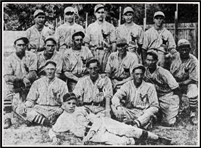
SILURIA TEAM PLAYS IN STATE MEET MONDAY. The Birmingham News, Sunday, September 3, 1933. "Photo of Buck Creek Team with comments, "Pictured above is the strong Buck Creek
team of Siluria which has scored 67 victories to 6 defeats in play during the current season.
Led by Dee Miles, Johnny Thomas and Herman Ware, a former Beaumont hurler, this
squad has perhaps the best rounded pitching corps in amateur baseball. Both of
the former slabsmen have rung up 19 wins to a duo of losses. Buck Creek is to
meet Jacksonville Monday in one of two Labor Day contests in the state amateur
championship tournament. Standing: Sonny Birchfield, utility; Chuck Harris,
second base; Hilton Tubbs, shortstop; Fern Ward, left field; Jack Husley,
utility. Kneeling: Nigger Yates, catcher; Russell Lowery, first base; Tobe
Moore, third base; Red Amos, pitcher; Toots Brandon, catcher; Moose Parrish,
manager. Sitting: Dee Miles, pitcher; Johnny Thomas, pitcher, Herman Ware,
pitcher; Buddy Moore, mascot." (Henry Clay "Moose" Parrish was born January 28,
1902 and died March 3, 1975 in Clarke County Georgia. The 1930 Randolph County
North Carolina census indicates his occupation was "Fielder, Ball Player" and he
was living in the next household to Hilton L. "Toots" Brandon, "Pitcher, Ball
Player". Toots died in 1973 in Caddo County Oklahoma. Charles Hulet "Chuck"
Harris was born February 27, 1907, died April 9, 1986, and is buried in
Elliottsville Cemetery in Shelby County Alabama. For many years he served as
Chief of Police in Siluria.)
The medical needs in the village for many years were
provided by Dr. John Allen Hines, Sr., 1896-1959, and his faithful nurse, Miss
Mollie Belle Vinzant, 1900-1987. In July 1951 Dr. Willie Elijah "Bill" Stinson,
1907-1971, arrived in Siluria and his faithful nurse for many years was Miss
Evelyn Urmi, 1900-1997.
Mrs. T.C. Thompson provided for the safety and security
of the village by maintaining a small jail located behind the main mill
building. In January 1903 "Tom Benton, a negro murderer, escaped from jail at Siluria, Ala., and for three days held
a posse of officers at bay, killing one of them." William Francis "Frank" Fallon, 1872-1962, was
later responsible for the
daily operation of the jail. Mr. J.T. Phillips later filled this position with
Charles Hulet "Chuck" Harris, 1907-1986.
After the death of Mr. T.C. Thompson on October 5, 1922
his family operated Buck Creek Cotton Mills. Mrs. T.C. Thompson served as
President from October 12, 1922 until her resignation on October 5, 1931. On
June 25, 1935 James Thomas Phillips was elected as
a member of the Board of Directors to fill the vacancy "caused by the
resignation of Frank Dominick." Mr. J.T. Phillips on February 8, 1937 was
elected President and Treasurer of Buck Creek Cotton Mills and within that year
had acquired the corporation, the operating facility, and all factory and
village property.
As reported in the Shelby County Reporter, dated June 18, 1925 written by Probate Judge L.B. Riddle, "Shelby County has in Siluria a live progressive community.
Siluria is a town and community that all of Shelby county should feel proud of. A visit to this town will convince you at first sight that things are in order
and are well kept. There is absolutely as nearly as possible a perfect sanitation system, they have all modern conveniences, such as electric lights, water works, sewerage,
paved or graded and graveled streets, and the premises are so neatly and correctly kept, that you feel at once that you are breathing pure wholesome atmosphere, and her people
are enjoying as a result, the finest health and are free as a whole from any infections or contagious troubles, that are at some other places quite frequent. The writer
with some friends had the pleasure
of visiting this well kept and well regulated community, last Monday and our whole party were of one mind in saying this is beyond a doubt the nicest and best kept and regulated town
that it has been our pleasure to visit in some time. The schools are kept running for the full nine months and they have there now aside from the grammar school and
a fully accredited high school from which the graduates
can enter any of the colleges of the state without examination. We are told that there are now employed by this company families that are represented by three generations, that is to say,
the boy, his father and his grandfather,
all accruing from men who were employed there at the beginning of the mill's operations twenty-two years ago. That is seems, certainly speaks volumes for both employer and employee.
Men have not only raised their families in this town and at this mill, but are so well satisfied that they remain and their sons and daughters are rearing their families there in the
same place
and in the same way. We are also informed that they are one of the few mills able to run full time and will be throughout the whole year. As Mr. Stroud, the genial and obliging gentleman that he
is, informed us that he has contracts enough to keep his mill going till October when the new crop will be on. Mrs. T.C. Thompson, the president of the mill is an able and efficient officer
and is the immediate successor of
her late husband T.C. Thompson. Mr. W.F. Stroud the vice-president, and general manager, is a most efficient and competent official and treats his employes as he would be treated.
Then Mr. G.W. Turnipseed, the superintendent of the mill, has few equals, and no superiors in his line as he makes all the folks feel that they are indispensable in the
carrying on of this valuable business. Then to there is the mill foreman, Mr. John Inglett, who has a smile and kind word for everyone, and they all feel that they would be ruined
without Mr. Inglett.
Then it is common knowledge that order must be kept, and so Mr. W.F. Fallon is always on the job and the boys say that he has the best eyes of anybody in the county. There are very
few violations and
when they occur they are usually taken care of right there by Sheriff Fallon,
and the Hon. J.L. Walker who is ever found to be true and yet tempers justice
with mercy. There are numerous other valuable formen and individual that space
forbids of mentioning just here. We must not fail to mention the Blue Spring
Farm and Dairy that is about the most ideal and up to date of its kind that it
has been our pleasure to see. The last referred to is under the able management
of Mr. Reed, who has his line well in hand and knows everything in detail about
dairying and farming. Then we were royally entertained in the magnificent home
of Mrs. Thompson, and we enjoyed so much the luxuries and hospitality of this
noble woman. Last but not least we find that two churches, Methodist and Baptist
work together in a most unusually friendly way, and the flocks are kept well
under guarded by their noble Shepherds, Revs. James Steele and Rufus W. Stuckey.
The Sunday schools and B.Y.P.U. and Epworth League as well as other noble and
worthwhile auxiliaries, such as the W.M.S. and Ladies Aid with their splendid
leaders are well on their way to success. Now let us show our appreciation of communities like Siluria and we might do well to study and to emulate their methods in so far
as they will help each of us to make our communtieis better. In conclusion, let us say that our hats are off to Siluria."
On April 18, 1953 a tornado
damaged the plant to the extent that operation had to be suspended for a full
year while repairs were made. At this time, more modern equipment was installed
in some departments to make the mill more competitive.
I refer you to the pictorial book by Bobby Joe and Diane (Brandenberg) Seales "Alabaster & Siluria:
The Early Years ~ A Pictorial History" that was released in November 2017. This book
can now be found in the National Library of Congress.
Siluria was incorporated on May 25, 1954 with a
population of approximately 600. The first city leaders were (1) Mayor: Tollie
Eugene Jones, 1906-1985. (2) Council: Burrell Brannon, Willie H. Brogden,
1904-1976, Dr. Willie Elijah "Bill" Stinson, 1907-1971, Bascom L. Vinzant,
1906-1987, and Cecil Brown Zuiderhoek, 1899-1987. (3) Town Clerk: Frances
(Nabors) Duke Wilson, 1919-1996. (4) Chief of Police: Charles Hulet "Chuck"
Harris, 1907-1986. The people of Siluria on April 27, 1971 voted to merge with
Alabaster, the adjoining city.
Siluria was the birth place for Ann M. Steely,
born July 6, 1923, and is where she lived her first seven years and attended the
first grade at Thompson. After her father's death in 1935 in Dallas County
Alabama she later moved with her mother and brother to Oklahoma and then in 1944
"packed her bags to try her luck in Hollywood." Ann Steely changed
her "acting name" to Cathy O'Donnell and made her screen debute in
the Best Picture of 1946 in The Best Years of Our Lives. Her final
film before retiring from the screen was another classic Hollywood's greatest,
the Best Picture of 1959 and winner of eleven total Oscars, was Ben-Hur.
Her parents were Harold Grady "Henry" Steely and Ora Lecher Steely. The April 3,
1930 Siluria Village, Shelby County, Alabama census indicates Harold G. Steely,
age 37 years, born in Alabama, his parents born in Alabama, married at the age
of 29 years, "School Teacher" and his wife, Ora L., age 24 years, born in
Alabama, her parents born in Alabama, married at the age of 17 years, and their
two children, all born in Alabama, (1) Ann M., daughter, age 6 years, and (2)
Joe C., son, age 4 years 7 months. Living with them as "boarders" were two 21
year old single school teachers, Mary S. Burkette and Eva Johnson. In a May 2005
interview with Fred F. Phillips, who moved to Siluria in 1927, the Steely's
"Mill Village House" was located next to the Community House. Some of their
neighbors were Arnold C. Edwards, Homer Stanley, Alice Cofer, Berry Cofer, Riley
Cofer, Samuel W. Huddleston, Lester Williams and James C. Goff. Mr. Steely was
not only a school teacher at Thompson but also was the local theatre operator,
located in the Community House, in Siluria. Ann married Robert Wyler, brother of
director William Wyler. Ann S. Wyler died April 11, 1970 in West Hollywood, Los
Angeles County, California. Her husband, Robert Wyler, died January 16, 1971.
They had no children. For more information about "Cathy O'Donnell "CLICK
HERE.
In December 1959 J.W. Valentine Co., Inc. from New York
purchased the operating facility, factory site, and all the village property.
The name of the business was again changed and this time it became Siluria
Mills, Inc.
The final name of the business was changed in January
1965 to Buck Creek Industries, Inc. and the village houses were sold to the
employees. The operating facility and factory site was sold in 1968 to Reeves
Brothers, Inc., a New York Stock Exchange, and in 1972 to Canton Textile Mills,
Inc. from Canton, Georgia. Assets were liquidated in May 1979 and Buck Creek
Industries, Inc. closed its doors permanently. The Birmingham News, page
58, dated Thursday, May 10, 1979, "A textile mill which was once the largest
onsite employer in Shelby County is closing its doors this week ...."
The Siluria Cotton Mills water tower was constructed in 1903.
It was beautifully restored as a $320,000 project by the City of Alabaster and in June 2023 was presented as a
historical landmark of Siluria.
In 2003 the City of Alabaster purchased the 22 acre Buck
Creek Cotton Mills site. In August 2007 the demolition of the buildings were
started by Granger Grading of Alexander City, Alabama. At that time, the city's
plans were to have all of the buildings taken down except for the old jail, the
water tower and the office building. In January 2008 only these three structures
remained standing. However, in early 2009 the office building was taken down due
to structural damage caused when the attached portion of the mill was
demolished.
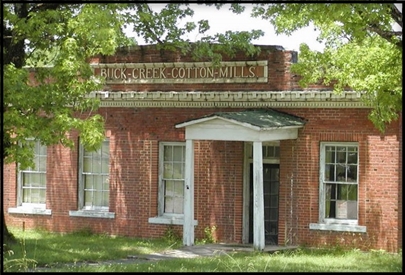 Note the name on the front of the office building before it was demolished in
early 2009
Note the name on the front of the office building before it was demolished in
early 2009
Buck-Creek-Cotton-Mills
On September 19, 2010 the City of Alabaster held the
grand-opening of the "new" Senior Center, built by the Montevallo-based Wayne
Davis Construction Company, that is located on a portion of the site where the
Buck Creek Cotton Mills once stood.
The remaining two structures from the Buck-Creek Cotton Mills in Siluria are the Buck Creek Jail and Water Tower. They
were both recognized and placed on the Alabama Register of Landmarks and Heritage on March 29, 2018.
If you have any further historical information or
photographs concerning Buck Creek Cotton Mills, Siluria or further information or corrections on any of the people, dates, or
events mentioned above please contact
Bobby Joe or Diane Seales.
Visit "Lord, How that Old Whistle Blew!" written by Rusty Kendrick.
Copyright - Bobby Joe Seales - 2000
|

